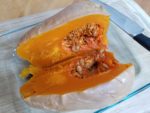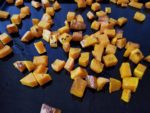Winter Squash
Winter squash is characterized by its thick skin and hard, orange or green flesh. It is a member of the curcubit, or gourd, family of vegetables, which also includes summer squash, melons, and cucumbers. Winter squash is rich in beta carotene and vitamins B and C, and is also a good source of magnesium and potassium.
There are many types of winter squash. Some of the more common ones include:
- Butternut squash – shaped somewhat like a pear with a tan rind
- Acorn squash – acorn-shaped with a dark green ridged rind
- Delicata squash – a smallish, oblong squash with a thin creamy yellow rind striped with green. The rind of this squash is tender and edible.
- Buttercup squash – round, with a dark green rind striped with lighter green and a light green “cap” on its blossom end
- Red kuri squash – an orange, teardrop-shaped squash with an edible rind.
To Store
You can keep winter squash for a month or so on your kitchen counter. If you want to keep it for longer, it is best to store it in a cool dark place such as a basement. Wipe off any dirt with a damp cloth and check for soft spots before storing.
Once cut, refrigerate unused portion.
Preparation
Rinse your squash before preparing. You can use a vegetable brush or clean cloth to get all dirt off.
Bake
 You can bake squash whole or halved. To bake whole, place the whole squash on a baking sheet or pan. Bake at 400° until it can be easily pierced with a fork – from 30 minutes to 1 ½ hours, depending on the size of the squash. Remove from the oven and slice in half. Use a spoon to scrape out the seeds.
You can bake squash whole or halved. To bake whole, place the whole squash on a baking sheet or pan. Bake at 400° until it can be easily pierced with a fork – from 30 minutes to 1 ½ hours, depending on the size of the squash. Remove from the oven and slice in half. Use a spoon to scrape out the seeds.
To bake halved, first cut off the stem end, cut the squash in half or in quarters (for larger squash), and scoop out the seeds. Place squash pieces on a lightly greased sheet or pan. Bake at 400° until it can be easily pierced with a fork, about 30-45 minutes.
From here you can do many different things: Season the flesh and eat it as is. Or scoop it out and use for mashes and soups. Or you can stuff the squash halves and put them back into the oven to heat the filling through. The last method works especially well for smaller squashes like acorn or delicata.
Microwave whole or halved
Poke winter squash a few times with a fork or a knife. Microwave at full power for 5 minutes for smaller squash and 10 minutes for larger squash. If the squash is still firm, microwave in short intervals until it can be easily pierced with a fork. Let cool, then cut in half, scoop out seeds, and cut or mash as desired. This method works for all winter squashes.
Roast cubed
 Cut off the stem and peel the squash with a vegetable peeler or knife. Butternut squash can be cut in half between the neck and the bulb to make peeling easier.
Cut off the stem and peel the squash with a vegetable peeler or knife. Butternut squash can be cut in half between the neck and the bulb to make peeling easier.
Then halve and seed the squash and cut into 1 inch cubes. Place the squash on a sheet pan in one layer. Drizzle with olive oil, salt, and pepper, and toss well. Roast for 25 to 30 minutes, until tender, turning once.
This works best for large squash like butternut and buttercup.You can roast slices of smaller squashes like acorn or delicata without peeling.
If you have trouble peeling winter squash, microwave it for 3 minutes to make peeling easier.
Steam on the stovetop
Cut off the stem, peel the squash, and scoop out the seeds. Cut the squash into 1 inch cubes. Place in a pot with a little bit of water and cook over medium heat, covered, until tender, 7-10 minutes. The cooked squash can be mashed or used in recipes that call for cooked squash.
Steaming works best with squash varieties that aren’t too difficult to peel, such as butternut squash and kabocha squash, or squash that doesn’t require peeling such as delicata squash.
How to Use Winter Squash
- Roast or steam cubed or sliced squash, alone or with other vegetables
- Add cubed or mashed squash to soups, stews, or casseroles
- Use mashed squash in baking, in any recipe calling for squash or pumpkin
- Add to pasta sauces
- Add to chili
- Eat halved and baked acorn squash right from the shell. Add butter and little brown sugar or maple syrup.
Check out our winter squash recipes:
Spaghetti Squash Lasagna with Spinach
Curried Butternut Squash and Lentil Soup
Roasted Butternut Squash Tacos
